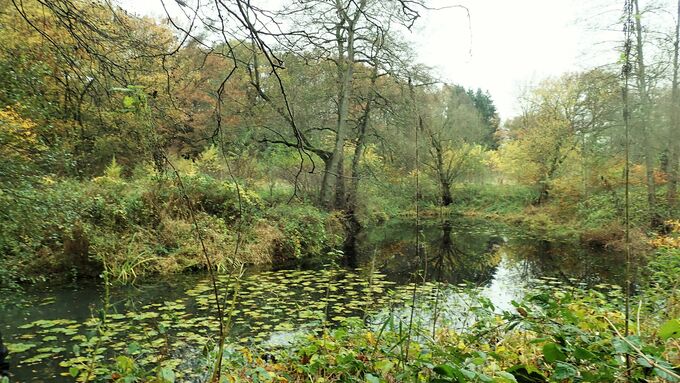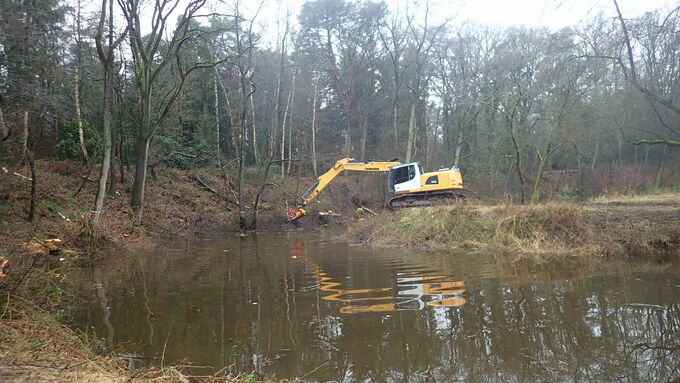Before the action started, the cut-off meander was shaded, had a high input of leaves and shallow water areas were largely missing. © Leonie Braasch, NLWKN
download picturemain content
Project of the month
#12/2022 DREDGING IN THE NATURAL MONUMENT ‘HUNTE-ALTWASSER BEI DER WIEKAU‘
The floating water-plantain gets another chance
Near the river Hunte at the weekend area ‘Wiekau’ near Wildeshausen (district of Oldenburg), passers-by come across a special waterbody: the incised, curving cut-off meander with strongly fluctuating water levels lies on a Geest slope from which nutrient-poor groundwater seeps, and used to harbour an exceptional inventory of plant species. For this reason, it was placed under protection as a natural monument in 1986. At that time, mass populations of the floating water-plantain (Luronium natans) were also found in this water meadow. Over the years, however, fewer and fewer specimens of this rare plant species could be detected; by 2021, the floating water-plantain had finally disappeared completely.
As a result, the LIFE IP team at the NLWKN, together with the Lower Nature Conservation Authority of the district of Oldenburg and a biologist who has been mapping this plant species for two decades on behalf of the NLWKN, decided to carry out an action at the cut-off meander. Since the floating water-plantain has very resistant and durable seeds, reactivation is still possible after years through targeted optimisation. A suitable measure was developed in cooperation with the owner of the area, the Hunte-Wasseracht, the fishing association Wildeshausen and the town of Wildeshausen.
In February 2022, selected trees of which the branches extended over the cut-off meander were felled by the Hunte-Wasseracht in order to reduce the nutrient input through leaf fall. Beforehand, an information event had taken place on site to inform interested people and the local group of NABU about the aims of the project and the upcoming tree felling work. This allowed for clarifying questions and avoiding misunderstandings. Due to the steep, approximately five-metre-high cliff edge at the waterbody, the woodcutting work was relatively complex. The removed wood could be re-installed as deadwood in other water habitats by the water and soil association.
In a second step, a dredger with a long arm worked on the cut-off meander in October 2022. The layer of mud that had reappeared since the last desludging in 2015 was removed as far as possible (on average about 20 centimetres). In addition, shallow water zones were created at four areas along the edge. In such areas, the likelihood of the flating water-plantain regaining ground is particularly high. A very thin layer of mud from the cut-off meander containing potential seeds of the floating water-plantain was spread on the shallow water areas to increase the probability of germination. The remaining silt and sand was spread on the peninsula directly adjacent to the cut-off. The area was made available for this purpose by the fishing association Wildeshausen. The area was then seeded with ‘regio-seed’ in order to provide as little space for establishment of alien plant species as possible. The pipe connection to the river Hunte was also filled in so that as little nutrient-rich water as possible can get from there into the nutrient-poor cut-off meander.
All involved parties are now curious to see whether the floating water-plantain will be discovered again in large numbers in the cut-off meander in the next few years.
Related Topics
Further Links
- Implementation notes for the protection of the floating water-plantain – Lower Saxony Water Management, Coastal Defence and Nature Conservation Agency (NLWKN) (in German) (external link opens in a new window)
- District of Oldenburg – Department for Nature Conservation and Landscape Management (in German) (external link opens in a new window)
- Overview upon natural monuments near the town of Wildeshausen (in German) (external link opens in a new window)





